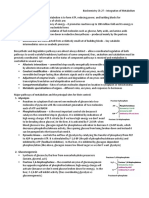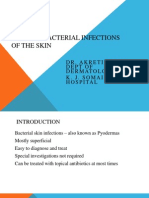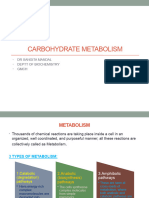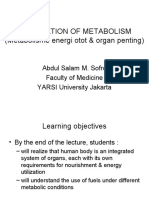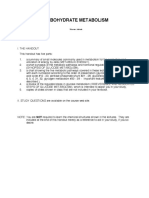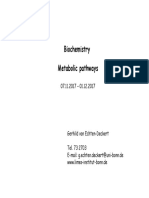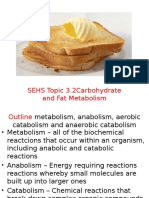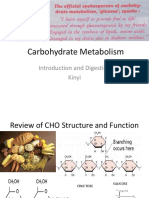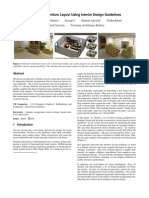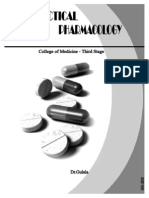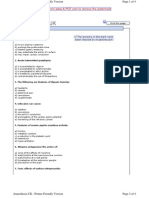Integration of Metabolism
Integration of Metabolism
Uploaded by
leenaloveuCopyright:
Available Formats
Integration of Metabolism
Integration of Metabolism
Uploaded by
leenaloveuCopyright
Available Formats
Share this document
Did you find this document useful?
Is this content inappropriate?
Copyright:
Available Formats
Integration of Metabolism
Integration of Metabolism
Uploaded by
leenaloveuCopyright:
Available Formats
CHEM464/Medh, J.D.
Integration of Metabolism
Metabolic Fate of Glucose
Each class of biomolecule has alternative fates depending on the metabolic state of the body. Glucose: The intracellular form of glucose is glucose-6phosphate. Only liver cells have the enzyme glucose-6-phosphatase that dephosphorylates G-6-P and releases glucose into the blood for use by other tissues G-6-P can be oxidized for energy in the form of ATP and NADH G-6-P can be converted to acetyl CoA and then fat. Excess G-6-P is stored away as glycogen. G-6-P can be shunted into the pentose phosphate pathway to generate NADPH and ribose-5-phosphate.
Metabolic Fate of Fatty Acids
Fatty acids are oxidized to acetyl CoA for energy production in the form of NADH. Fatty acids can be converted to ketone bodies. KB can be used as fuel in extrahepatic tissues. Palmityl CoA is a precursor of mono- and polyunsaturated fatty acids. Fatty acids are used for the biosynthesis of bioactive molecules such as arachidonic acid and eicosanoids. Cholesterol, steroids and steroid hormones are all derived from fatty acids. Excess fatty acids are stored away as triglycerides in adipose tissue.
CHEM464/Medh, J.D. Integration of Metabolism
Metabolic Fate of Amino Acids
Amino acids are used for the synthesis of enzymes, transporters and other physiologically significant proteins. Amino acid N is required for synthesis of the cells genetic information (synthesis of nitrogenous bases). Several biologically active molecules such as neurotransmitters, porphyrins etc. Amino acids are precursors of several hormones (peptide hormones like insulin and glucagon and Amine hormones such as catecholamines). Aminoacids can be catabolized to acetyl CoA, pyruvate or intermediates of the TCA cycle for complete oxidation.
Central Themes of Metabolic Pathways
Acetyl CoA is a common intermediate of all metabolic pathways. It interconnects glucose, fatty acid and amino acid metabolism. Oxidation of dietary fuel leads to the capture of energy in the form of ATP and NADH / FADH2. NADH / FADH2 transfer their electrons to O2 via the electron transport chain. The energy released is used to synthesize ATP. ATP is the biochemical currency of energy. Several thermodynamically unfavorable reactions are made possible by the coupled hydrolysis of ATP. Biosynthesis involves the reduction of simple carbon compounds to complex polymers. Most biosynthetic processes make use of NADPH as the electron donor. Biosynthetic and degradative pathways are distinct and coordinately regulated.
CHEM464/Medh, J.D. Integration of Metabolism
Common Mechanisms of Metabolic Regulation
Allosteric regulation: Enzymes that catalyze irreversible steps are targets of feed-back inhibition or feed-forward activation. Regulation is rapid but short-lived Covalent modification: Phosphorylation of enzymes enables overall nutritional / metabolic status of the body to regulate metabolic pathways at key regulatory steps. Low concentration of triggering signals can have an amplified effect. Regulation is transient by last long enough to affect the next step in a regulatory cascade. Enzyme mass: Endocrine signals can affect the transcription /translation of key regulatory enzymes
Common Regulatory Mechanisms (continued)
Energy charge/Reduction potential of the cell: Catabolism is favored by a low energy charge and low NADH/NAD+ ratio. Compartmentation within the cell: catabolic substrates are kept apart from enzymes by cellular compartments until a signal is received Metabolic specialization of organs: In higher organisms, specialized metabolic functions are performed by specific tissues / organs. Eg: the liver monitors and maintains the blood levels of key metabolites, the adipose tissue stores triglycerides.
CHEM464/Medh, J.D. Integration of Metabolism
Endocrine Regulation of Metabolism
Metabolic processes are tightly regulated by the concerted actions of hormones. Hormones regulate enzyme primarily by covalent phosphorylation The three main endocrine signals that regulate metabolism are epinephrine, glucagon and insulin. Epinephrine is responsible for the mobilization of glucose (glycogenolysis) and an inhibition of enzyme activities of fuel storage pathways. Glucagon also increases breakdown of glycogen, but in addition, it promotes gluconeogenesis in the liver. Insulin opposes the functions of both glucagon and epinephrine. It stimulates the uptake of glucose from the blood, stimulates glycogen and FA biosynthesis and inhibits FA oxidation
Major Metabolic Control Sites
Glycolysis: Aerobic glycolysis oxidizes one molecule of glucose to 2 molecules of pyruvate. NAD+ is regenerated by the ETC. Under anaerobic conditions, pyruvate is reduced to lactate for the regeneration of NAD+. Phosphofructokinase is the key regulatory enzyme. It catalyzes the committed step of glycolysis: conversion of F6-P to F-1,6-BP. It is activated by F-2,6-BP and inhibited by citrate. The levels of F-2,6-BP (the allosteric activator) are regulated by a bifunctional enzyme with phosphofructokinase 2 activity and fructose bisphosphatase activity. Dephosphorylation of the bifunctional enzyme activates the kinase but inactivates the phosphatase. This leads to higher levels of F-2,6-BP and activation of glycolysis.
CHEM464/Medh, J.D. Integration of Metabolism
Major Metabolic Control Sites
Gluconeogenesis: This pathway is most active in the liver and to some extent in the kidneys. Glucose is synthesized from non-carbohydrate presursors such as lactate, pyruvate, oxaloacetate, glycerol and amino acids. Glycolysis and gluconeogenesis are reciprocally regulated. When one is highly active the other is minimally active. The key regulatory enzyme is fructose-1,6bisphosphatase. This enzyme is activated by citrate and inactivated by F-2,6-BP.
Major Metabolic Control Sites
The TCA cycle and Oxidative phosphorylation: These are common pathways for the oxidation of carbohydrates, fats and amino acids. There is a tight coupling of the TCA cycle to the ETC. The electrons captured in NADH / FADH2 via the TCA cycle are immediately transported along the ETC for reduction of O2 to H2O and synthesis of ATP. Since the availability of O2 depends on respiration, the activity of the TCA cycle depends on the rate of respiration. Two key regulatory enzymes of the TCA cycle are isocitrate dehydrogenase and -ketoglutarate dehydrogenase. Major allosteric inhibitors are ATP and NADH.
CHEM464/Medh, J.D. Integration of Metabolism
Major Metabolic Control Sites
Fatty acid -oxidation: Fatty acids are oxidized to acetyl CoA in the mitochondria The fatty acids have to be activated to acyl CoA and then transported to the mitochondria prior to oxidation Tranportation requires that the acyl group be transferred from CoA to carnitine by the enzyme carnitine acyltransferase I. The transport of acyl CoA to the mitochondria is the committed step (and key regulatory step) of FA oxidation Carnitine acyltransferase I is inhibited by malonyl CoA, a committed intermediate of the FA biosynthesis pathway.
Major Metabolic Control Sites
Fatty acid biosynthesis: fatty acids are synthesized in the cytosol from acetyl CoA. Malonyl CoA is an activated intermediate; its formation is the committed step in FA biosynthesis. It is catalyzed by acetyl CoA carboxylase The transport of acetyl CoA to the cytosol is facilitated by the citrate shuttle. Both the citrate shuttle and acetyl CoA carboxylase are inhibited by palmitoyl CoA, the end product of FA biosynthesis. Citrate is a precursor for fatty acids and sterols and it is a positive allosteric activator of acetyl CoA carboxylase.
CHEM464/Medh, J.D. Integration of Metabolism
Metabolic Profiles: Brain
The brain accounts for 20 % of the energy requirements of the body, mostly to maintain membrane potential required for transmission of nerve impulses. Normally, glucose is the sole preferred fuel of the brain. The brains consumption of glucose and oxygen are constant regardless of resting/ sleeping or active/ waking state. The brain cannot store glycogen, it must receive a constant supply of glucose through the blood. Brain cells have a glucose transporter, GLUT3, with a low Km for glucose. In the event of starvation or disease, the brain cells adapt quickly and utilize ketone bodies that are made in the liver.
Skeletal Muscle
Skeletal muscle metabolism is different from that of brain in three main ways: Muscle fuel needs are dependent on activity level. Muscle can store glycogen. If glucose is not available, glycogen stores are hydrolyzed by the active muscle. Muscle cells lack the enzyme glucose-6-phosphatase, thus, muscle glycogen cannot supply glucose to the circulation and other tissues. Muscle can use both glucose and fatty acids and occasionally even amino acids as fuel.
CHEM464/Medh, J.D. Integration of Metabolism
Skeletal Muscle (continued)
The resting muscle prefers fatty acids as fuel. The active muscle undergoing rapid contraction prefers glucose. During high activity, anaerobic respiration ensues and glucose metabolism produces high levels of lactate which is transported to the liver (Cori cycle). During high activity, a large amount of alanine is formed by transamination of pyruvate. This is also sent to the liver (alanine) for disposal of N as urea.
Cardiac Muscle
Heart metabolism is different from skeletal muscle in 3 ways. Heart muscle can function only under aerobic conditions. Heart muscle cells are rich in mitochondria facilitating aerobic respiration. Heart muscle is not able to store glycogen. Fatty acids are the preferred fuel of the heart. Glucose is the least favored fuel. Ketone bodies and lactate are used under stress when the energy demand is high.
CHEM464/Medh, J.D. Integration of Metabolism
Adipose Tissue
Adipocytes are specialized storage cells for triglycerides. They hold 50 to 70 % of the total energy stored in the body. The TG stores of adipose tissue are continually being synthesized and degraded. TG hydrolysis is catalyzed by hormone sensitive lipase (HSL). Epinephrine stimulates the covalent phosphorylation and activation of HSL. The glycerol formed is exported to the liver. The FA formed are used to reesterified if glycerol-3-phosphate is available (when glucose levels are high). When glucose levels are low, fatty acids are released into the circulation. When metabolic fuel is in excess, triglycerides are transported to the adipose tissue for storage. Here, extracellular lipoprotein lipase hydrolyzes TG to MAG and FA for cellular uptake. They are reassembled back to TG once inside the cell.
Kidney
The major task of the kidney is excretion. Water-soluble metabolic waste products are excreted in the urine. Excess water is removed and the osmolarity of body fluids is maintained. The final composition of urine is determined after several cycles of filtration and reabsorbtion to avoid loss of useful biomolecules. The energy required by the kidneys for this function is supplied by glucose and fatty acids. The kidneys are a minor site of gluconeogenesis (liver is the major site). During starvation, the kidneys can contribute significant amounts of blood glucose
CHEM464/Medh, J.D. Integration of Metabolism
Liver
The liver supplies metabolites and fuel molecules to all peripheral organs. The liver cannot efficiently use glucose or ketone bodies as fuel. It prefers fatty acids and -keto acids as a source of energy for its activities. After absorption by the intestine, dietary fuels first destination is the liver. The liver is able to gauge fuel availability and adjust its metabolism to regulate the level of various metabolites in the blood. Hepatic lipid metabolism:When fatty acids are in excess, they are exported to the adipose tissue for storage as TG. TG are transported as VLDL particles assembled from newly synthesized or dietary fatty acids. In the fasting state, liver converts fatty acids into ketone bodies.
Carbohydrate metabolism in liver
The liver removes 2/3 of glucose from the circulation. This is phosphorylated to G-6-P by glucokinase and meets different metabolic fates. Very little is oxidized for supplying energy to the liver. The liver converts excess G-6-P to acetyl CoA for the synthesis of fatty acids, cholesterol and bile salts. The liver has an active pentose phosphate shunt. This supplies NADPH for reductive biosynthesis. When glucose levels are low, liver stores of glycogen can be shared with other organs because of the presence of the enzyme glucose-6-phosphatase. The liver is responsible for gluconeogenesis. The substrates for gluconeogenesis are lactate and alanine from the muscle, glycerol from adipose tissue and glucogenic aa from the diet.
10
CHEM464/Medh, J.D. Integration of Metabolism
Amino acid metabolism in liver
The liver absorbs most of the dietary amino acids from the blood. Amino acid are preferentially diverted to protein synthesis rather than catabolism. This is possible because the Km for aminoacyl tRNA synthetase is lower than that for catabolic enzymes. AA catabolism takes place when the anobolic pathways are saturated. Liver is the only organ capable of sequestering N as urea for disposal. The -keto acids derived from aa enter the gluconeogenesis pathway. They serve as a primary source of energy for the liver.
Metabolic changes during normal starved-fed cycle
The major goal of metabolism is to maintain glucose homeostasis at about 80 mg/dl. Immediately after a meal, blood glucose levels are high; this stimulates the secretion of insulin from pancreatic cells. Insulin is a signal of the fed-state. It triggers metabolic events designed to remove dietary fuel for storage as glycogen or TG. Insulin stimulates glycogen synthesis in liver and muscle. Hepatic glycolysis is stimulated leading to fatty acid biosynthesis. Glucose supply to adipose tissue is increased leading to synthesis of TG for storage. Insulin stimulates aa uptake and protein synthesis by muscles
11
CHEM464/Medh, J.D. Integration of Metabolism
Metabolic changes during normal starved-fed cycle
The blood glucose levels drop several hours after a meal. This leads to a decrease in insulin levels but a rise in glucagon levels Glucagon signals the starved state. It acts by stimulating cAMP-dependent protein kinase A. Glucagon stimulates glycogen breakdown and inhibits glycogen synthesis in the liver. It inhibits glycolysis and stimulates gluconeogenesis. Glucagon inhibits FA biosynthesis and increases oxidation. Adipose TG stores are hydrolyzed to FA by the activation of hormone-sensitive lipase. Glucagon stimulates hydrolysis of muscle proteins for harvesting energy from aa carbon.
Adjustment to refed state after overnight fast
Dietary fuel from a breakfast is processed slightly differently by the liver than during a continued fed-state. The liver spares the glucose for peripheral tissues. Instead it continues to synthesize glucose by gluconeogenesis. Since the blood glucose levels are above normal, the newly synthesized glucose is now diverted to replenish glycogen stores. Once glycogen levels are restored, liver stops gluconeogenesis and extracts most of the glucose from the blood. Fatty acid processing switches to fed-state metabolism immediately after a breakfast.
12
CHEM464/Medh, J.D. Integration of Metabolism
Metabolic adaptation during prolonged starvation
Even during prolonged starvation, blood glucose levels have to be maintained at 40 mg/dl to provide fuel to the brain. During the first day of starvation, the glycogen stores are used up. The liver tries to keep up with gluconeogenesis to supply glucose to the brain but cannot keep up because of lack of substrates such as glycerol, lactate, pyruvate etc. Since proteins are not stored, any breakdown of protein results in loss of function. Thus proteins are preferred only when other sources are exhausted. The use of proteins for energy results in wasting.
Metabolic adaptation during prolonged starvation
Most of the stored energy is in the form of fat which cannot be converted to glucose (except the glycerol of the TG). Increased acetylCoA formation but lack of oxaloacetate results in the formation of ketone bodies whose levels go up steadily about 3 days into starvation. The brain switches to using ketone bodies instead of glucose. This spares the proteins from degradation for gluconeogenesis. Starvation can be fatal because of protein loss as well as ketoacidosis (ketone bodies are acidic). A low carb, high protein diet is a kind of controlled starvation forcing the body to use stored fat energy but still protecting the protein.
13
CHEM464/Medh, J.D. Integration of Metabolism
Metabolism during Diabetes
Type I or Insulin-dependent diabetes (IDDM): These individuals suffer from an inability to synthesize insulin because of autoimmune destruction of -cells of pancreas. Glucose entry into cells is impaired due to lack of insulin. Type II or Non-insulin depedent diabetes (NIDDM): This is due to a developed resistance to insulin. The cells are unable to respond to insulin and glucose entry into cells is impaired. In both forms of diabetes, cells are starved of glucose. The levels of glucogon are high and metabolic activity is similar to that in starvation.
Metabolic Patterns in Diabetes
Diabetic subjects are constantly relying on protein and fat for fuel. Proteins are degraded for gluconeogenesis. Glycolysis is inhibited and gluconeogenesis is stimulated. This exaggerates hyperglycemia; glucose (and water) are removed in urine. The diabetic subject suffer from acute hunger and thirst. A lack of insulin action leads to mobilization of fat from adipose tissue, -oxidation and formation of ketone bodies. In general metabolism shift from carbohydrate usage to fat usage. Excessive buildup of ketone bodies leads to lowering of the pH. When the kidneys cant keep up with acid-base homeostasis, ketoacidosis can be fatal.
14
CHEM464/Medh, J.D. Integration of Metabolism
Obesity
In most cases obesity is a direct result of overeating and a sedentary life-style. Biochemically, appetite and caloric expenditure are controlled by a complex process involving the brain and adipose tissue. Leptin is a protein synthesized by the adipose tissue; it is called as the satiety factor. Leptins target organ is the hypothalamus. This is the part of the brain that controls food intake. Leptin secretion is directly related to adipose mass. In the presence of leptin, the hypothalamus tells the body to stop food intake. In other words, there is satiety or a loss of appetite. When adipose stores are being depleted leptin synthesis declines and appetite returns. Genetic obesity may be due to impairment of leptin action. The defect may be in the leptin protein itself, or its signaling pathway.
Type I and Type II Muscle Fibers
A short fast sprint is anaerobic exercise; a prolonged steady marathon is aerobic in nature. ATP is required to power movement by muscle myosin. Muscle ATP stores are very limited. There are two kinds of muscle fibers, type I and type II. Type I fibers have extensive blood (and O2) supply, are rich in mitochondria with a high activity of enzymes of TCA cycle, oxidation and ox phos. These fibers participate in aerobic exercise Type II fibers are poorly supplied with blood (and O2), are low in myoglobin and have very few mitochondria. They have a very active glycolytic pathway and have high levels of the enzyme phosphocreatine kinase. Type II fibers contribute to anaerobic metabolism during a sprint. Atheletes can train to increase their abundance of Type I or Type II fibers
15
CHEM464/Medh, J.D. Integration of Metabolism
Metabolism during a short sprint
In muscle cells, ATP can also be generated by phophoryl transfer from phosphocreatine (or creatine phosphate): Phosphocreatine + ADP � ATP + creatine (enzyme: phosphocreatine kinase). Phosphocreatine is a reservoir of rapidly available high energy phosphate bonds. Only one reaction is required to transfer energy from phosphocreatine to ATP. The stores of phosphocreatine in the muscle are very limited; they are used up within the first 5-6 sec of a sprint. Once phophocreatine stores are depleted, energy harvested by anaerobic glycolysis kicks in. This is a slower but more sustained source since glycogenolysis supplies adequate glucose At the end of a 100-meter sprint, muscle ATP levels drop to half, phosphocreatine is completely depleted, lactate and H+ levels increase dramatically.
Metabolism during a marathon
If anaerobic respiration continues during the duration of a marathon, it will result in acidosis. Within a few minutes of intense exercise, the muscle obtains its ATP by aerobic metabolism. This is significantly slower; thus the speed of a marathon runner is about half as much as that of a sprinter. For long distance running energy is derived from a simultaneous breakdown of muscle and liver glycogen and oxidation of fatty acids. Marathon runners have a low blood glucose level leading to high glucogon: insulin ratio. Both glycogen and adipose stores are mobilized. High FA oxidation leads to excess acetyl CoA. This slows down PDH and glycolysis, sparing some glucose till after the marathon.
16
CHEM464/Medh, J.D. Integration of Metabolism
Metabolism of Ethanol
Ethanol is metabolized primarily in the liver. Ethanol is oxidized by a two-step process:
CH3CH2OH + NAD+ � CH3-CHO + NADH + H+ (enzyme: alcohol dehydrogenase) CH3-CHO + NAD+ + H2O � CH3-COOH + NADH + H+ (enzyme: aldehyde dehydrogenase)
Ethanol consumption leads to an accumulation of NADH This favors formation of lactate from pyruvate (enz:LDH):
CH3COCOOH + NADH + H+��CH3CHOHCOOH + NAD+
Thus, alcohol consumption can lead to lactic acidosis. To neutralize the acid, acetate can be converted to acetyl CoA by mitochondrial thiokinase in a reaction requiring ATP.
Acetate + CoA + ATP � acetylCoA + AMP + PPi
Alteration of liver metabolism by ethanol
Excessive alcohol consumption causes liver damage in 3 stages: fatty liver, hepatitis and finally cirrhosis. Excess NADH inhibits -oxidation; FA accumulate in the liver as TG causing liver enlargement and fatty liver. NADH inhibits regulatory enzymes of the TCA cycle; excess acetyl CoA is diverted to ketone bodies exacerbating the acidity caused by lactate accumulation. Accumulation of acetaldehyde leads to covalent modification of proteins and impairment of their functions. All of these changes eventually lead to liver cell death. This triggers an inflammatory response causing hepatitis. Development of fibrous structures and scar tissue around dead cells impairs most of the livers biochemical functions. This is called liver cirrhosis. A rise in blood NH4+ levels can be fatal.
17
You might also like
- Biochem CH 27 Integration of MetabolismDocument6 pagesBiochem CH 27 Integration of MetabolismSchat Zi100% (1)
- Bacterial Infections of The SkinDocument41 pagesBacterial Infections of The Skinleenaloveu100% (2)
- Integration of MetabolismDocument17 pagesIntegration of MetabolismSharif M Mizanur RahmanNo ratings yet
- Metabolism OverviewDocument43 pagesMetabolism OverviewWinnet MaruzaNo ratings yet
- Introductionto MetabolicregulationDocument25 pagesIntroductionto Metabolicregulationsyedabismaahmad8No ratings yet
- Integration of Metabolism: Dr. Farzana Hakim Assistant Professor Biochemistry DepartmentDocument63 pagesIntegration of Metabolism: Dr. Farzana Hakim Assistant Professor Biochemistry DepartmentGriffin100% (1)
- BCH 303 Integration of Metabolism Lecture NotesDocument34 pagesBCH 303 Integration of Metabolism Lecture Notesamiryusufsani87No ratings yet
- Summary of MetabolismDocument33 pagesSummary of Metabolismmememe123123No ratings yet
- Biochemistry Final - Integrated - Metabolism-16Document113 pagesBiochemistry Final - Integrated - Metabolism-16keisha jonesNo ratings yet
- Fed State of MetabolismDocument40 pagesFed State of MetabolismBHARANIDHARAN M.VNo ratings yet
- Carbohydrate Distribution, Metabolism, and ExcretionDocument93 pagesCarbohydrate Distribution, Metabolism, and ExcretionPSPD - Hana Athaya NNo ratings yet
- BCH 209-Liver AllDocument36 pagesBCH 209-Liver AllJessica IfeleNo ratings yet
- Carbohydrate MetabolismDocument134 pagesCarbohydrate MetabolismdridreesbtsonNo ratings yet
- CARBOHYDRATE METABOLISM-DrSangitaDocument34 pagesCARBOHYDRATE METABOLISM-DrSangitaA MINOR100% (1)
- Integration of MetabolismDocument40 pagesIntegration of MetabolismIrfanArifZulfikar100% (1)
- Metabolisme Makronutrien FixDocument132 pagesMetabolisme Makronutrien FixbelaariyantiNo ratings yet
- 19.biosynthesis of Lipids - 17-43Document28 pages19.biosynthesis of Lipids - 17-43kihobok439No ratings yet
- Metabolisme Lipid (2012)Document78 pagesMetabolisme Lipid (2012)fmdsNo ratings yet
- J. Biosynthetic PathwaysDocument14 pagesJ. Biosynthetic PathwaysMary Rose Bobis VicenteNo ratings yet
- CarbohydratesDocument32 pagesCarbohydratesgumedeneliswa483No ratings yet
- Chapter 16 - Lipid MetabolismDocument8 pagesChapter 16 - Lipid MetabolismadambridgerNo ratings yet
- Carbohydrate MetabolismDocument30 pagesCarbohydrate MetabolismWycliff MuchaiNo ratings yet
- Integration of MetabolismDocument40 pagesIntegration of Metabolismseada JemalNo ratings yet
- Integration of MetabolismDocument40 pagesIntegration of MetabolismSofie Hanafiah NuruddhuhaNo ratings yet
- BIO 202 Biochemistry II by Seyhun YURDUGÜL: Carbohydrate Metabolism I GlycolysisDocument59 pagesBIO 202 Biochemistry II by Seyhun YURDUGÜL: Carbohydrate Metabolism I GlycolysisYasin Çağrı KılıçerNo ratings yet
- 01 Regulation of Organic Metabolism and Energy BalanceDocument65 pages01 Regulation of Organic Metabolism and Energy Balancetaserullah95No ratings yet
- 21BTC101T - Biochemistry - Unit - IIIDocument95 pages21BTC101T - Biochemistry - Unit - IIIriyare23No ratings yet
- Tissue-Specific MetabolismDocument35 pagesTissue-Specific MetabolismLulu100% (2)
- Cholesterol MetabolismDocument35 pagesCholesterol MetabolismDeepthiNo ratings yet
- Carbohydrate MetabolismDocument19 pagesCarbohydrate MetabolismAbhithNo ratings yet
- FAT Metabolism - QMPlus No Notes or NarrationDocument27 pagesFAT Metabolism - QMPlus No Notes or Narration2jpkdb4hstNo ratings yet
- 1.4.5.4 - Hubungan Antar MetabolismeDocument32 pages1.4.5.4 - Hubungan Antar MetabolismeMulyanti YanthieNo ratings yet
- Glyconeogenesis - BIO 3110Document23 pagesGlyconeogenesis - BIO 3110NaiomiNo ratings yet
- Metabolism Interaction and Hormone Regulation.Document81 pagesMetabolism Interaction and Hormone Regulation.fikaduNo ratings yet
- Lecture 11 On Regulation of MetabolismDocument23 pagesLecture 11 On Regulation of MetabolismSaad KazmiNo ratings yet
- Overview of Metabolism & The Provision of Metabolic Fuels (CHP 16 Harper) - TJLDocument6 pagesOverview of Metabolism & The Provision of Metabolic Fuels (CHP 16 Harper) - TJLM100% (1)
- Metabolism of CarbohydratesDocument90 pagesMetabolism of Carbohydratesashailiyan80No ratings yet
- Chapter 4-IIDocument36 pagesChapter 4-IIefiNo ratings yet
- Biochemistry of CVSDocument311 pagesBiochemistry of CVSAsne ManNo ratings yet
- Carbohydrates MetabolismDocument47 pagesCarbohydrates MetabolismDaffa OfficialNo ratings yet
- CARBOHYDRATE METABOLISM Power Point Lecture NotesDocument32 pagesCARBOHYDRATE METABOLISM Power Point Lecture NotesAnthony AnibasaNo ratings yet
- Metabolic Interrelationships Rev 2020-Lecture-StdsDocument79 pagesMetabolic Interrelationships Rev 2020-Lecture-StdsKavin AbdurrahiemNo ratings yet
- Lipid 3 Energy Production From Lipid 2023Document36 pagesLipid 3 Energy Production From Lipid 2023M. Ilham Ramadhan AsihNo ratings yet
- Cellular Respiration DR - Neveen by Maye Ragab 2019Document20 pagesCellular Respiration DR - Neveen by Maye Ragab 2019ahmedabdeltwab671No ratings yet
- GlycolysisDocument17 pagesGlycolysisSourav DasNo ratings yet
- CyclesDocument32 pagesCyclesSanjana VasistNo ratings yet
- Lipid MetabolismDocument79 pagesLipid Metabolismgeediyow22No ratings yet
- Carbohydrate Metabolism - AnggelDocument32 pagesCarbohydrate Metabolism - Anggeldrnewton03No ratings yet
- Intergrated MetabolismDocument117 pagesIntergrated MetabolismDerick SemNo ratings yet
- 2023 Met Integration MDB 203Document32 pages2023 Met Integration MDB 203Samiwell Oluwakayode EbenezerNo ratings yet
- Chapter Viii - Carbohydrates MechanismDocument34 pagesChapter Viii - Carbohydrates MechanismAngelo AngelesNo ratings yet
- Sehs Topic 3 2 Carbohydrate and Fat MetabolismDocument20 pagesSehs Topic 3 2 Carbohydrate and Fat Metabolismapi-343368893No ratings yet
- Carbohydrates, Lipid and Protein Metabolism: Guyton and Hall Textbook of Medical Physiology (14th Ed.), Chapters 68-70Document107 pagesCarbohydrates, Lipid and Protein Metabolism: Guyton and Hall Textbook of Medical Physiology (14th Ed.), Chapters 68-70Prixie AntonioNo ratings yet
- 2 - Intro and GlycolysisDocument54 pages2 - Intro and Glycolysiskasozi marvinNo ratings yet
- Metabolisme Dan TermoregulasiDocument56 pagesMetabolisme Dan TermoregulasiMuhammad Iqbal100% (1)
- 4 - Metabolism of CarbohydratesDocument14 pages4 - Metabolism of CarbohydratesmooshadabNo ratings yet
- Metabolism IntegrationDocument10 pagesMetabolism IntegrationValine Cysteine MethionineNo ratings yet
- Keto Simplified: The science behind the low carb lifestyleFrom EverandKeto Simplified: The science behind the low carb lifestyleNo ratings yet
- Fast Facts: Long-Chain Fatty Acid Oxidation Disorders: Understand, identify and supportFrom EverandFast Facts: Long-Chain Fatty Acid Oxidation Disorders: Understand, identify and supportNo ratings yet
- The Physiology of Cell Energy Production: CPTIPS.COM MonographsFrom EverandThe Physiology of Cell Energy Production: CPTIPS.COM MonographsNo ratings yet
- PajerododDocument16 pagesPajerododleenaloveuNo ratings yet
- FurnitureDocument9 pagesFurnitureDezyne EcoleNo ratings yet
- Scabies and PediculosisDocument35 pagesScabies and PediculosisleenaloveuNo ratings yet
- Thyroid Function Tests: What Is The Thyroid Gland?Document8 pagesThyroid Function Tests: What Is The Thyroid Gland?Rahadiyan HadinataNo ratings yet
- Papulosquamous DisordersDocument51 pagesPapulosquamous DisordersleenaloveuNo ratings yet
- Practical PharmacologyDocument17 pagesPractical Pharmacologyleenaloveu100% (2)
- Pharmacology - MCQsDocument28 pagesPharmacology - MCQsleenaloveu100% (4)
- Fungal InfectionsDocument42 pagesFungal InfectionsleenaloveuNo ratings yet
- Outlines in PathologyDocument200 pagesOutlines in PathologyLisztomaniaNo ratings yet
